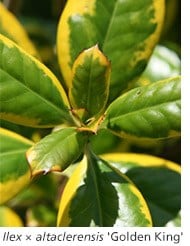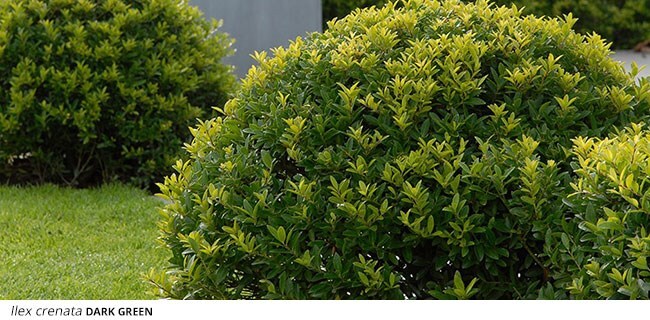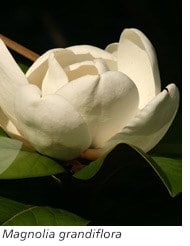|
Winter cuts through the garden as effectively as a sharp knife removing any remaining summer froth and exposing the bare bones beneath. With most of the plants having either shed their leaves, or gone underground to escape the rigours of the season, only the evergreens remain, true and proud, and they seize the limelight taking centre stage, positively glowing in the winter light.
This season of minimalism is the perfect opportunity to look at the garden framework and add some touches of magic to liven up those strategically placed areas - close to steps, by doorways or along a path. Here topiary will work a treat. Clip according to your setting, either creating formal shapes, such as the tiered wedding cake, or opt for softer organic shapes by cloud cutting into mounds and humps. Whichever you choose, winter will highlight every contour and bring out the best.
.
The king of the evergreens
The holly reigns supreme in winter, but there are decisions to be made. If you want berries you can’t close clip and topiarise because you’ll cut away the flowers. You have to allow your holly to flourish on its own, with just a yearly spring trim, in order to get those red winter jewels. You must also make sure that you plant a female variety because hollies are dioecious (meaning two houses), and male and female flowers appear on separate bushes - and it’s only the female bushes that produce berries. In built up areas there’s usually plenty of male pollen carried around by the bees to pollinate the females, but in remoter areas you will need to plant a male holly as well. One male though, will serve a whole harem of female hollies.
A holly by any other name?
You can’t go by name, for some so-called Kings are indeed females and some so-called Queens are males masquerading as ladies by name only. There is an exception though. One green-leaved holly berries on its own because it's self-fertile - Ilex aquifolium‘J.C. van Tol’. However the berries cluster down the stems rather than in traditional clusters above the foliage. Most holly berries disappear once cold weather arrives, so if you want them for festivities pick them in early December and store them somewhere cool. Leave plenty for the birds though!
Hardy garden hollies come in a few main types. The English holly (Ilex aquifolium) is sharp and prickly and therefore needs careful siting. It's masochism to plant this in a border that you have to weed by hand, or to put it close to walkways. Aquila is Latin for eagle - so think eagle talons as a reminder of how sharp those leaves really are. However English hollies make superb specimen plants in a lawn, or placed in strategic positions. Many of them from majestic shapes.
Most popular English hollies have some variegation which lights up the foliage. Ilex aquifolium 'Argentea Marginata' is an old 18th century variety known as the broad-leaved silver holly. The shiny green leaves, crisply margined in custard-cream yellow, set the clusters of red berries off. This clips really well, or it can be left to form a small tree and the new flush of spring growth will add a pink glow.
Highclere holly (Ilex x altaclerensis) is a natural hybrid between English holly and a tender large-leaved holly (I. perado) from The Azores. The two met when it became common to grow this large-leaved tender holly in orangeries in the 18th and 19th centuries. Bees carried pollen from these hothouse beauties to the wild hollies in the woods. The hybrid was first recorded and named at Highclere House in Berkshire by Loudon in 1838. Altaclerensis means the house of clere. The home of Downton was the first place this larger leaved holly was found, but it was soon discovered in many other places too.
 One of the most highly regarded is Ilex x altaclerensis ‘Golden King’. This is a female berrier, despite its manly name, with rounded dark green leaves shaded in grey and then edged randomly in bright creamy yellow. Like all Highclere hollies, it’s faster growing than English holly and can be topiarised into standard mop heads, or it can be used to form a hedge. It’s also good left to its own devices and, however you use it, it creates its own bolt of winter sunshine. One of the most highly regarded is Ilex x altaclerensis ‘Golden King’. This is a female berrier, despite its manly name, with rounded dark green leaves shaded in grey and then edged randomly in bright creamy yellow. Like all Highclere hollies, it’s faster growing than English holly and can be topiarised into standard mop heads, or it can be used to form a hedge. It’s also good left to its own devices and, however you use it, it creates its own bolt of winter sunshine.
There is another holly to mention, the box-leaved holly - Ilex crenata ‘Dark Green'. This is very different from what you would class as a normal holly, and it would be understandable if you actually thought it was from the buxus family with its small glossy leaves, but this is a Japanese holly frequently used in their gardens which is not affected by box blight, the bane of many gardeners.
Evergreen, and slow growing the deep green, occasionally spiny leaves are perfect for topiary, such as balls, cones, or even complicated cloudshaped forms. It will happily grow in sun or partial shade in the ground or in pots, but if the latter best to protect the roots by wrapping the pot in bubble wrap or frost fleece to stop the roots freezing in the winter.

More doorstep evergreens
In winter we often catch glimpses of the garden close to porches and doorways as we rush in and out. One evergreen that’s perfect close to the house is the highly scented sarcococca or Christmas box. These are members of the box family, but they come from Western China mainly and arrived here in 1908 after their black berries were collected. The most elegant of all, with ivory-white flowers and shiny rich green leaves, is Sarcococca confusa. It’s so called because when it was recorded it couldn’t be found in the same place and the botanist named it tongue in cheek. The lily-like fragrance wafts through the air on still winter days, so try to keep this in a sheltered position. It also does well in a container and is the best thing for hedonists to grow by their doorway.
It’s debatable which sarcococca is the most fragrant, because they all pack a powerful punch. S. hookeriana, a pink-flowered form with grey-green foliage, comes in several forms. Sarcococca hookeriana var. digyna is the most heavily scented in my opinion, but the pink flowers are not as clean cut. Sarcococca hookeriana var. digyna 'Purple Stem' produces willow-like stems in purple and it suckers although not aggressively so. 'Ghorepani', a more recent introduction from Nepal, has cream-white flowers and there’s also a hybrid called ‘Winter Gem’ which has larger leaves and pink and white flowers. These are winter essentials and the easiest of the fragrant winter-flowering plants to accommodate in your garden.

A South-facing wall
 Some evergreens need a large expanse on a warm wall and these include Magnolia grandiflora and Clematis armandii. Both have leathery green foliage and both stand out well in winter. Magnolia grandiflora is well named for its enormous lemon-scented white flowers are among the grandest of all. The common name, bull bay or Southern magnolia, reflects an American provenance of a tree sometimes found in maritime areas. The thick brown indumentum (a velvety layer on the undersides of the leaf), is the colour of snuff and this also stands out well in winter light. It wins the title for most tactile evergreen of all. Some evergreens need a large expanse on a warm wall and these include Magnolia grandiflora and Clematis armandii. Both have leathery green foliage and both stand out well in winter. Magnolia grandiflora is well named for its enormous lemon-scented white flowers are among the grandest of all. The common name, bull bay or Southern magnolia, reflects an American provenance of a tree sometimes found in maritime areas. The thick brown indumentum (a velvety layer on the undersides of the leaf), is the colour of snuff and this also stands out well in winter light. It wins the title for most tactile evergreen of all.

There are compact varieties too such as ‘Little Gem which bears many cup-shaped flowers between April and August, but the buds are sumptuous long before it flowers and those leaves look good all year round. Then you have a gorgeous range bred in New Zealand by Mark Jury, (who also bred the stunning deciduous Magnolia ‘Black Tulip’ but we digress here!) who has raised M. ‘Fairy Cream’ and ‘Fairy Blush’. These stunning magnolias which are evergreen/semi-green, so they can drop their leaves in a cold winter, are compact bushy plants with dense deep green leaves, perfect for a smaller garden. Plant in a sheltered spot, and from March to May you will be rewarded with many lightly scented, cup-shaped blooms, even on young plants, which then can have a second flush later in the year.

Clematis armandii comes in many forms, but ‘Apple Blossom’ produces blush-pink starry flowers in spring and these are highly fragrant. ‘Snowdrift’ is a spidery pure-white with narrower high-gloss leaves. All will develop some brown foliage, because this is the plant’s natural way of shedding leaves throughout the year. These can be snipped off with scissors and, if your Clematis armandii rambles outside its allocated space, you can prune it in late-spring or early summer - once it has become established.
 Your south-facing wall is also suitable for winter-flowering clematis particularly forms of C. cirrhosa. The form from Majorca, Clematis cirrhosa var. balearica, has ferny dark green leaves and lightly spotted, pendent greenish white bells early in the year. These will be mobbed by any early-emerging bees, so it’s well worth planting. ‘Freckles’ will often flower before Christmas, with more heavily spotted white flowers. All produce leggy plants that can be trained round windows or doors and then you can gaze up into the bells. Do not prune these and be aware that they can shed all their leaves in dry summers, feigning death as effectively as a Pre-Raphaelite poet - but they revive once rain returns. Your south-facing wall is also suitable for winter-flowering clematis particularly forms of C. cirrhosa. The form from Majorca, Clematis cirrhosa var. balearica, has ferny dark green leaves and lightly spotted, pendent greenish white bells early in the year. These will be mobbed by any early-emerging bees, so it’s well worth planting. ‘Freckles’ will often flower before Christmas, with more heavily spotted white flowers. All produce leggy plants that can be trained round windows or doors and then you can gaze up into the bells. Do not prune these and be aware that they can shed all their leaves in dry summers, feigning death as effectively as a Pre-Raphaelite poet - but they revive once rain returns.
You could also grow a myrtle, so symbolic of love and immortality that every bridal bouquet has to have a sprig or two. Myrtus communis subsp. tarentina, a compact Mediterranean shrub with pale pink petals that frame fibre-optic arrangements of fine stamens - each tipped in yellow. This can often flower late in the year in the shelter of a wall, but it isn’t scented. If you want scent plant the straight species Myrtus communis.
More evergreens for leaf alone

The Victorians loved evergreens and they planted Aucuba japonica widely. Familiarity shouldn’t breed contempt though, for the all-green leaves of ‘Rozannie’ are a high gloss rich green and red berries also follow. These long-lived shrubs grow far faster than holly and create the same effect and they tolerate deep shade. There are splashed aucubas too, such as ‘Crotonifolia’ that can light up dank corners.
Or you could use another Victorian favourite, Viburnum tinus, an evergreen viburnum with pretty sprays of pink buds that open to white. ‘Eve Price’ forms a good roundel or there is a newer red-budded form called ‘Lisarose’.
 Red and green set each other off, adding extra winter warmth. In late winter the new foliage of Photinia x fraseri ‘Red Robin’ emerges a brilliant scarlet, so it really stands out strongly. This is a shrub that tolerates shade too. Understandably these are very popular shrubs which can get quite large, but now there are some new introductions that are perfect for the smaller garden. P. × fraseri 'Little Red Robin', as the name suggests has all the attributes of the larger plant but only grows to about 1m tall. If you want that flash of colour but something even smaller and compact for a pot on the patio, then Photinia × fraseri CHICO ('BR2011') is the one for you. All the photinia are better grown in a sheltered south or west facing aspect to protect them from frosts.
A subtler blend of green and red can be seen on Portuguese laurel (Prunus lusitanica), with linear green leaves held on red stems. This can be used as hedging, but it also can be clipped to form cubes, cones and roundels and it’s very underrated. It looks divine in winter. Red and green set each other off, adding extra winter warmth. In late winter the new foliage of Photinia x fraseri ‘Red Robin’ emerges a brilliant scarlet, so it really stands out strongly. This is a shrub that tolerates shade too. Understandably these are very popular shrubs which can get quite large, but now there are some new introductions that are perfect for the smaller garden. P. × fraseri 'Little Red Robin', as the name suggests has all the attributes of the larger plant but only grows to about 1m tall. If you want that flash of colour but something even smaller and compact for a pot on the patio, then Photinia × fraseri CHICO ('BR2011') is the one for you. All the photinia are better grown in a sheltered south or west facing aspect to protect them from frosts.
A subtler blend of green and red can be seen on Portuguese laurel (Prunus lusitanica), with linear green leaves held on red stems. This can be used as hedging, but it also can be clipped to form cubes, cones and roundels and it’s very underrated. It looks divine in winter.
Last but not least, Choisya is another shrub that can be clipped into low mounds for winter interest, or left to flower. The finely divided foliage of ‘Aztec Pearl‘ sets off almond-scented, blush-white flowers that appear in May (and often in late summer too) on an elegantly restrained shrub. C. ‘White Dazzler’ will dazzle you with masses of pure white scented flowers on an evergreen rounded, neat shrub. Easy to grow in any well drained soil, in sun or partial shade this is gorgeous plant can be grown in a pot or trimmed to make a small hedge. The dainty ‘Apple Blossom’ also retains its leaves throughout the year, but these are much finer than many of the others which gives the plant a more delicate appearance. Flowering from mid-to-late spring, and then often again in the autumn, pretty pink clusters appear from deep pink buds fading as they mature to a white, on a compact plant which is ideal for pots and smaller gardens.

. |














